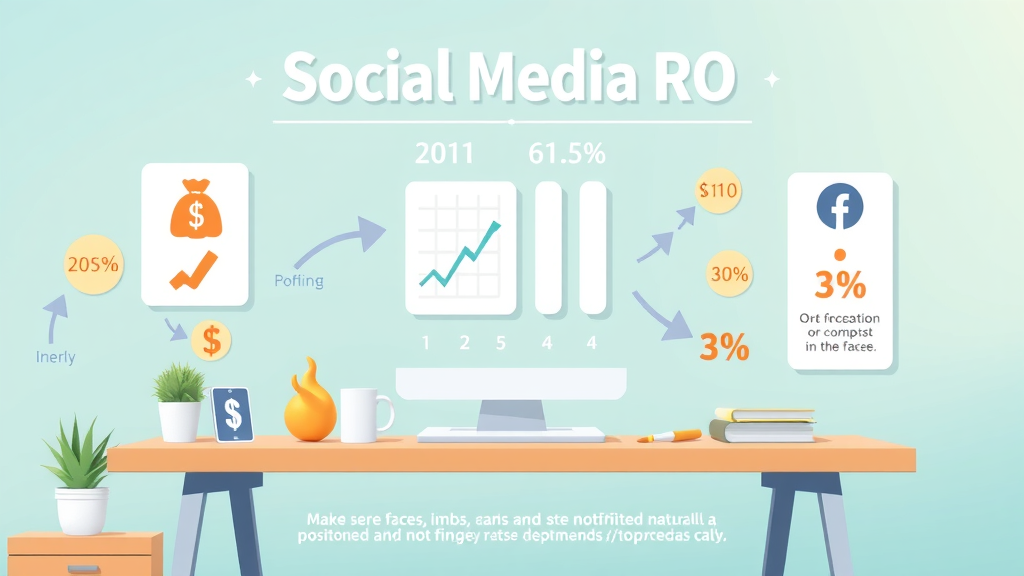Did you know that over 60% of marketers say measuring social media ROI is their biggest challenge—yet those who master it are twice as likely to beat their business goals? If you’ve ever felt lost trying to quantify your brand’s social media efforts, you’re not alone. The good news is, ditching the guesswork and calculating social media ROI with confidence doesn’t have to be complicated. In this guide, you’ll discover clear steps, practical formulas, and expert tools to make every media campaign count.
Unlocking the Value of Measuring Social Media ROI: Surprising Facts and Why It Matters
Understanding the true impact of your social media efforts is more than a numbers game—it’s the blueprint to smarter, more profitable media marketing. When you invest in precisely measuring social media ROI , you move beyond vanity metrics and face the real questions: Is your strategy bringing measurable returns, or just empty likes?
The stark reality is that brands with clear ROI tracking are twice as likely to achieve, if not exceed, their objectives. Yet, most businesses continue to rely on guesswork or surface-level reporting. This limits growth, wastes budgets, and can even mislead leadership about the value of media campaigns and paid ad investments. Recognizing the importance of proper social media ROI measurement sets you apart, empowering you with data to shape future strategy and secure buy-in across your organization.

"More than 60% of marketers cite measuring social media ROI as their greatest challenge, yet brands investing in precise tracking are twice as likely to achieve their business objectives."
Essential Concepts: Social Media, Social Media ROI, and Media Marketing in a Connected World
The landscape of media marketing has evolved rapidly. Today’s social media marketing is about more than just posts; it’s a dynamic integration of content, engagement, and performance metrics that intersect to drive genuine, measurable ROI for brands. Effectively measuring social media ROI requires understanding how these efforts contribute to larger business goals, such as increased revenue, improved brand awareness, or greater customer loyalty.
- Understand how social media , social media marketing, and media marketing intersect to drive measurable ROI.
In the connected age, a media campaign is not just about broadcasting messages. Each media platform—from Facebook and Instagram to Twitter and LinkedIn—delivers unique attribution data and user behaviors. The challenge and opportunity lie in integrating data from these sources for a holistic view of performance, ensuring every campaign is aligned with tangible business objectives and tracked consistently across channels.

What You’ll Gain: Mastering Measuring Social Media ROI, Analytics, and Practical Formulas
If you’re ready to move beyond basic engagement counts, you’re in the right place. By the end of this guide, you’ll confidently pinpoint which metrics matter for ROI, use the social media ROI formula effectively, and select analytics tools that take the guesswork out of measuring social media ROI . You’ll also master best practices to avoid common pitfalls—no fluff, just practical takeaways.
- How to define and track the right metrics for social media ROI
- The social media ROI formula and how to use it
- Tools to streamline measuring social media marketing effectiveness
- Best practices that avoid guesswork
With measurable KPIs, accurate attribution, and iteratively improved strategies, you’ll transform both organic and paid social performance from a “nice-to-have” to a proven revenue driver for your organization.
Why Measuring Social Media ROI Should Be at the Core of Your Social Media Efforts
Centering your social media marketing around ROI enables you to see what’s truly working—and what isn’t. Without clear ROI tracking, it’s easy to get caught up in activity that doesn’t actually impact your business. Measuring outcomes as a standard practice sets a benchmark for success while providing a scalable foundation for every future media campaign .
Whether your focus is building brand awareness , generating leads, or driving direct sales, tying your media efforts to tangible ROI ensures resources are allocated where they create the most value, transforming mere activity into strategic advantage.
Aligning Social Media Efforts with Business Goals to Maximize Media ROI
Great social media strategies map directly to specific business objectives, whether it’s increasing customer acquisition, boosting engagement on a key platform, or reducing churn. For real impact, it’s not enough to just “be present”—you need a roadmap that translates platform-specific actions into broader KPIs.
When every campaign objective ties directly to sales, leads, or high-priority brand milestones, your organization can optimize every dollar spent for the highest return on investment. Alignment means reviewing objectives before launching campaigns and measuring each stage of the customer journey with data rather than instinct.

Recognizing Common Pitfalls in Measuring Social Media Success
One of the biggest traps in measuring social media efforts is focusing solely on surface-level metrics, like likes or followers. While easily accessible, these rarely correlate with true business results. Another pitfall is failing to establish clear, measurable goals at the start of a media campaign , which leads to confusion about what defines “success.”
Many teams also overlook how media platforms attribute conversions differently, or they misinterpret multi-touch journeys by relying solely on last-click attribution. Avoiding these pitfalls starts with documenting goals aligned with business outcomes and choosing attribution models that fit your objectives and customer journey.
Getting Started: Setting Up to Measure Social Media and Media Marketing Performance
Before analyzing results, lay a solid foundation for your media marketing initiatives. The first step is clearly identifying core social media KPIs, such as engagement rates, click-throughs, and conversions. These will become the yardstick for assessing all future media efforts.
- Identifying your core social media KPIs
- Mapping your social media efforts to key business objectives
- Gathering baseline data with media marketing tools
Next, map out how each planned activity supports these objectives—do your paid ad campaigns push traffic to a specific funnel? Are you using organic social posts for brand awareness and nurturing prospects? Start collecting baseline metrics using reliable analytics tools , and compare results against these when measuring performance.
Selecting Metrics for Social Media ROI: Reach, Engagement, Conversion, and More
Each metric tells part of the story. Reach indicates how many unique users saw your content, while engagement captures the depth of interaction—likes, shares, comments, and more. Most importantly, conversion metrics (such as lead submissions, downloads, form fills, or direct purchases) link your social media efforts directly to business value.
It’s essential to focus not just on what you can measure, but what truly matters for your business goals. Blending paid social results with organic social data, and connecting actions across channels, creates a holistic view of campaign success. For complex customer journeys and multi-touch sales cycles, deploy advanced attribution models within media platform analytics to get even sharper clarity.

Integrating Social Media ROI Measurement into Digital Campaign Planning
Building measurement into your campaign planning from day one means fewer headaches later. Establish UTM parameters on every shared link, set up custom goals in your analytics tools, and define what success looks like before you start. This ensures reporting is turnkey and aligned to your top-level business KPIs—and enables continuous optimization based on hard data.
Embedding ROI measurement into planning also guarantees that every campaign—whether a quick paid ad test or a multi-month brand push—is judged on outcomes, not assumptions. This closes the loop between media strategy, execution, and measurable financial impact.
Understanding the Social Media ROI Formula: Calculating the True Impact
"The only way to know if your media marketing is working is to apply the right social media ROI formula to your data."
At its core, measuring social media ROI is about answering one question: for every dollar (or hour) you put in, what do you actually get back? Using a clear ROI formula eliminates ambiguity and lets you speak the language of business impact in any boardroom or budget discussion.
| Metric | How to Calculate |
|---|---|
| Social Media ROI (%) | (Profit from Social Media - Costs of Social Media) / Costs of Social Media × 100% |

This straightforward approach works for both top-line (revenue-focused) and bottom-line (cost-centric) goals, from paid ad campaigns to organic social outreach. All you need are accurate records of costs (including ad spend, content creation, and staff time) and clear, attributed profit numbers—usually tracked by effective use of analytics and UTM parameters.
Media ROI Formula vs. Social Media ROI Formula: What’s the Difference?
The media ROI formula is universal: (Profit - Cost) ÷ Cost × 100%. The social media ROI formula is simply this calculation customized for your social media marketing efforts, often zeroing in on campaign-specific expenses and profits. While the structure is the same, the input variables should be fine-tuned to represent only those activities and results directly tied to your media campaigns.
For instance, in social media marketing, calculating ROI involves social ad spend, software costs, and creative investments, balanced against any attributable sales or leads. Be clear whether you’re isolating a single media campaign or total annual media efforts and adjust your cost and profit accounting accordingly.
Step-by-Step: How to Measure Social Media ROI Accurately
The process of measuring social media ROI can be simplified into four actionable steps. Each step builds a solid foundation for accuracy and ensures data-driven decisions at every stage of your media marketing .
- 1. Set clear objectives
- 2. Track inputs and outputs
- 3. Utilize UTM parameters and Google Analytics
- 4. Use an ROI calculator
Begin by documenting your target outcomes. Next, keep scrupulous records of every investment, from media team salaries to third-party tools. Apply unique UTM tags to every shared link, ensuring Google Analytics or your analytics tool can attribute conversions correctly. Finally, plug real numbers into a trusted ROI calculator each month or quarter to evaluate performance—and adjust strategy where needed.
Leveraging Google Analytics and UTM Parameters to Improve Measuring Social Media ROI
Tagging your campaign URLs with UTM parameters transforms Google Analytics into a precision tool for measuring social media ROI . Every visitor, click, and conversion is mapped to its source, medium, and campaign, making it easy to trace which platforms and efforts drive the best results throughout the customer journey .
To maximize insight, create unique UTM tags for every media campaign and combine them with clear naming conventions. This enables granular reporting in Google Analytics, letting you compare the performance of paid social ads versus organic social posts and directly linking your strategy to measurable outcomes.

Instant Calculation: Using ROI Calculators for Social Media ROI Assessment
Dedicated ROI calculators streamline the often labor-intensive math of measuring social media ROI . These tools pull in cost, revenue, engagement, and conversion data automatically and apply the standard ROI formula for instant, accurate reporting.
Choose a calculator—either within your preferred analytics platform or as a standalone utility—that syncs with your data sources. Doing so removes human error and lets you focus on tweaking creative, adjusting budget, and scaling what works across all social media platforms .
Beyond Likes: Measuring Social Media ROI for Paid and Organic Social Media Marketing
True ROI measurement goes far beyond tallying likes or follower counts. Paid social campaigns deliver clear, attributable conversions, while organic social often builds brand awareness and nurtures long-term loyalty. For a full accounting of your performance, you must blend data from both streams and use multi-touch attribution models to assign appropriate value to each step in the customer’s journey.
- Understanding ROI on paid social campaigns
- Measuring organic reach and conversion
- Blending multiple attribution models for comprehensive analysis
Start by using analytics tools—like Facebook Insights, Google Analytics, and platform APIs—to collect engagement and conversion data. Map these against spend on paid ad campaigns and time invested in organic social initiatives to create a true, apples-to-apples ROI comparison.

Best Strategies for Media Efforts: Optimizing Social Media ROI across Channels
To optimize media efforts across every channel, prioritize cross-platform analytics, consistent attribution tracking, and routine A/B testing of content. Work to unify reporting from all social media platforms , enabling an integrated, strategic overview instead of fragmented datasets.
Identify content types and messaging that drive the strongest engagement and conversion, then use insights to replicate success on high-performing platforms while phasing out unproductive efforts. Dynamically adjust resources and ad spend as new data emerges, ensuring you always invest where ROI is highest.
| Effort Type | Key Metrics | Typical Data Sources |
|---|---|---|
| Paid Social | Ad Spend, Clicks, Conversions, Revenue | Ad platform dashboards, Google Analytics, CRM |
| Organic Social | Engagement, Reach, Website Traffic, Assisted Conversions | Social platform analytics, Google Analytics |
Tools and Technologies for Measuring Social Media ROI Efficiently
Choosing the right analytics tools for measuring social media ROI makes all the difference between insightful reporting and endless spreadsheets. Leading social media ROI calculators —like Hootsuite Analytics, Sprout Social, and Google Data Studio—offer robust dashboarding, customizable KPI tracking, and even automated ROI calculations.
- Overview of top social media ROI calculators
- Features of modern analytics suites
- How to select tools tailored to your media marketing
Modern analytics platforms allow you to track multiple media campaigns across a variety of channels, segment your audience by behavior or funnel stage, and produce compelling reports for internal stakeholders. Before selecting a tool, document the metrics most valuable to your team and confirm seamless integration with your existing data sources and platforms.

Case Studies: Brands that Excel in Measuring Social Media Effectiveness
Market leaders like Nike, Airbnb, and Glossier have elevated the art of measuring social media ROI by integrating end-to-end analytics and rapid optimization into their media marketing . Nike, for example, deploys custom UTM parameters and automated dashboards to trace customer behavior from first click to final sale, letting them scale what works at a global level.
Meanwhile, Airbnb merges organic social engagement data with paid ad conversions in a single reporting tool, uncovering which channels deliver the best cost-per-acquisition. Glossier routinely A/B tests content and uses in-platform analytics tools to identify top-performing creative in real time, ensuring each post meaningfully contributes to their bottom line. These examples prove precise measuring social media ROI is not only possible, but game-changing when executed well.
Applying the Social Media ROI Formula to Your Marketing Initiatives
Kick-start your ROI measurement by mapping your campaign objectives to the ROI formula in a structured, stepwise fashion. This ensures every media effort aligns with key business outcomes and is backed by transparent, actionable data.
- Step-by-step calculation walkthrough
- Adapting the ROI formula to different business models
- Reporting results to stakeholders
Suppose your social campaign drove $20,000 in new sales and cost $5,000 in total spend (including ad costs, creative, and tools). Your ROI is: ($20,000 - $5,000)/$5,000 x 100% = 300%. Adjust inputs as needed for B2C, B2B, or service-driven models, and use clear, graphical reports when sharing ROI insights with leadership for maximum impact.
Common Challenges in Measuring Social Media ROI and How to Overcome Them
Despite best intentions, several obstacles can cloud accurate ROI measurement. Siloed data, inconsistent attribution across platforms, difficulty quantifying non-monetary results (like sentiment or service improvements), and unreliable reporting from fragmented media platforms top the list.
- Data silos
- Multi-touch attribution
- Quantifying non-monetary returns
- Improving media efforts tracking
Overcoming these hurdles means integrating your analytics, deploying regular data audits, and expanding definitions of value to include both quantitative and qualitative outcomes (such as improved customer service or elevated brand perception).
How to Troubleshoot Inconsistent Social Media ROI Data
If your ROI numbers seem “off,” first check data collection methods—ensure all UTM parameters are correctly implemented, conversion tags are firing, and platforms are syncing as intended. Test URL tagging, crosscheck revenue numbers with your CRM, and compare analytics snapshots from different tools to pinpoint discrepancies.
Regularly review and clean your data, retrain your team on proper campaign tagging, and run parallel reports during periods of change. A clear audit process will reveal—and help you fix—gaps or inconsistencies so you can trust your ROI insights fully.

Optimizing Social Media Efforts for Better ROI: Best Practices and Pro Tips
Continuous improvement should drive your approach to measuring social media ROI . Leverage A/B testing for both creative and calls to action, using results to iteratively refine campaigns. Routinely map budgets to the highest-performing efforts, and document every optimization for ongoing learning and scale.
- A/B testing for content performance
- Iterative improvements to media efforts
- Aligning budgets with measurable outcomes
Keep advancing by remaining agile—adapt goals and KPIs as your market and business needs evolve, and involve stakeholders at every level for accountability and shared success in every media marketing initiative.
People Also Ask: How do you measure ROI on social media?
Direct Steps for Measuring Social Media ROI
To measure social media ROI, follow these steps: Define specific, measurable campaign goals (e.g., sales, leads, brand awareness); track all costs and resources invested; use UTM parameters and analytics tools to attribute conversions to social media efforts; and apply the social media ROI formula: (Profit from social media - Costs of social media) ÷ Costs of social media x 100%. Consistent tracking and reporting are key for long-term success.
People Also Ask: What is a good ROI in social media?
Benchmarks and Industry Standards for Social Media ROI
A “good” ROI in social media can vary, but many brands target a return of 250-300% on paid campaigns (meaning for every $1 spent, $2.50–3.00 is generated in profit). However, benchmark numbers will shift by industry, campaign type, and goals—compare your performance to sector-specific benchmarks and focus on consistent improvement over time.

People Also Ask: What is social media ROI by revenue formula?
Applying the Revenue Formula for Measuring Social Media ROI
The revenue-oriented social media ROI formula is straightforward: (Revenue attributable to social media - Total social media costs) ÷ Total social media costs x 100%. This approach ties investments directly to actual sales conversions or revenue events, making it powerful for e-commerce, SaaS, and service businesses tracking end-to-end performance.
People Also Ask: What is the best way to measure ROI?
Selecting the Right Approach to Measure Social Media ROI
The best way to measure ROI is to integrate UTM tracking, use robust analytics tools, and monitor outcomes against clear, campaign-specific objectives. Pair quantitative results (sales, leads, conversions) with qualitative insights (such as improved brand awareness or customer service sentiment) for a well-rounded view of your media marketing performance.
Expert Insights: Measuring Social Media ROI That Inspires Action
"Actionable data dramatically reduces wasted social media marketing spending—data-driven ROI measurement is a competitive advantage." — Industry Expert
In today’s data-driven world, brands that leverage actionable, precise ROI measurement maintain a significant edge. They invest smarter, optimize faster, and confidently report results that win leadership trust and new budget. In short, mastering measuring social media ROI transforms media marketing from a cost center into a strategic driver of business growth.

Comprehensive FAQ for Measuring Social Media ROI and Media Marketing Success
- How often should ROI be measured in social media marketing? Track ROI consistently—ideally, after every major campaign and at least monthly for ongoing activities—to spot trends and adjust strategy swiftly.
- Can qualitative outcomes be included in social media ROI? Yes. While harder to quantify, qualitative results like customer loyalty, community growth, or improved customer service can add meaningful context to your ROI calculations.
- What are the most common mistakes in measuring social media efforts? Relying only on vanity metrics, failing to use proper attribution tools, and neglecting to define clear objectives before launching media campaigns are common pitfalls.
Maximize Your Impact: Next Steps to Accurately Measure Social Media ROI
- Set up your ROI tracking framework
- Engage with proven analytics tools and calculators
- Continuously review and optimize media marketing strategy
"Stop guessing. Start measuring social media ROI as a strategic imperative to unlock true value from every media effort."
Key Points to Remember When Measuring Social Media ROI
- Data-driven approach always wins
- Precision in measuring social media ROI builds credibility
- Optimization is an ongoing process
- ROI proves the true value of your social media efforts
Summary: The Formula to Measuring Social Media ROI Is Simpler Than You Think
Don’t overcomplicate it—define your goals, track your investment, use the right formula, and let clear data inform every decision. Measurable ROI is within reach for every social media marketer willing to follow a proven, disciplined approach.
 Add Row
Add Row  Add
Add 




Write A Comment